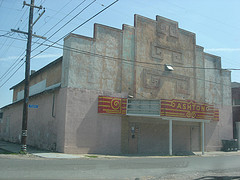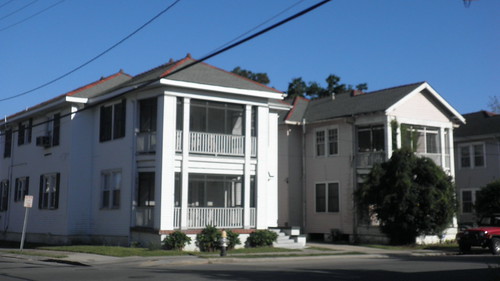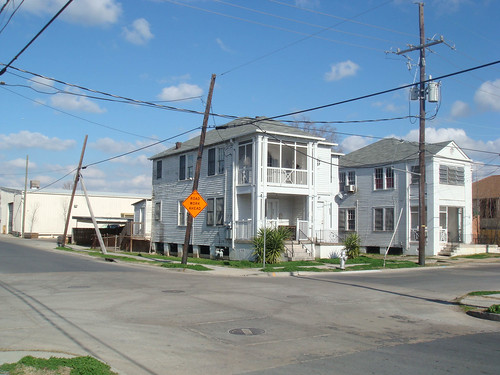 NorthWest Carrollton would like to work to have this building added to the National Historic Register. In addition to being one of the last old theatres in New Orleans, it was designed by Ferdinand Lucien Rousseve (1904–1965).
NorthWest Carrollton would like to work to have this building added to the National Historic Register. In addition to being one of the last old theatres in New Orleans, it was designed by Ferdinand Lucien Rousseve (1904–1965).
In April 1934 he sat for and passed the state licensing examination for architects, becoming the first licensed Black architect in Louisiana.
We are in contact with some of Rousseve's relatives that remain in the New Orleans Area.
The Ashton is currently owned by the
artist Lin Emory but is not open ot the public.
The websites below that provided this research are no longer working but this detail is some of the information that has been sent to NorthWest Carrollton on the Ashton Theatre.
__________________________________________________________________
/http://www.bookrags.com/tandf/ferdinand-lucien-rousseve-tf/
Ferdinand Lucien Rousseve (1904–1965)
John J.Burns Library, Boston College
Archives
Ferdinand
Rousseve was born on July 18,1904, in New
Orleans, Louisiana,
into a devout Catholic household headed by his
Creole father, Bartholomew, who was a postman, and his mother, Valentine Marie,
who was a housewife. Ferdinand had three brothers and four sisters including
twins, Leonie and Leona. His father faithfully recited the Rosary every morning
and raised his children to have devotion for the Virgin Mary. Ferdinand’s
sister, Theresa, married Jesus Christ by becoming a nun, and one brother,
Maurice, ordained his soul to the Catholic Church by becoming a priest. One
brother, Rene, was a social worker. Two brothers, Numa and Charles, who were
gifted artists, became a professional landscape painter and university professor of fine arts, respectively. Ferdinand, like two
of his brothers, chose a profession in the fine arts, but his oeuvre was forever ecclesiastically influenced.
Ferdinand’s
father enrolled him in Saint Louis Elementary, a private school in New Orleans,
and then successive New Orleans parochial schools—Holy Family Boys’ Middle School and Xavier Preparatory High School.
Ferdinand Rousseve was inspired to study architecture by his Xavier drafting
and industrial arts teacher, William Lewis. He graduated with academic honors
third in his class in June 1922.
Rousseve was a
smart and determined student who advanced his station in life by seeking out
and conquering the educational opportunities that presented themselves to him.
Following his graduation from high school, he enrolled at Guillaume
College in New Orleans in 1924 and received a diploma
from the commercial course. Also in 1924, he attended Coyne Trade and Engineering School in Chicago,
Illinois, earning a certificate in mechanical drawing and elementary machine design. The latter was a discipline in which patternmaker
RICHARD MASON HANCOCK had excelled. Rousseve returned to New Orleans and worked as a draftsman for
Louis J.Charbonnett, a family friend, mechanical engineer, and mentor and owner
of one of the leading millwright companies in the lower Mississippi Delta.
After Charbonnett died in 1924, Rousseve left for Cambridge, Massachusetts,
intending to enter the Massachusetts Institute of Technology. To prepare for the entrance examination, Rousseve enrolled at Rindge
Technical High
School in Cambridge.
It was a worthwhile investment of a year of study. He won a Gold Medal in
oratory and qualified for a four-year, full-tuition Cambridge scholarship.
The summer before he started college, he worked as a draftsman for Maginnis,
Walsh & Kennedy Architects, who specialized in church architecture. Rousseve
entered Massachusetts Institute of Technology in the fall of 1925. His
matriculation was highlighted by many honors, such as receiving a $1,000 scholarship grant from the Cambridge Rotary Club. He was the only African
American member of the Architectural Society and he was a dependable member of
the Catholic Club. He spent the summer of 1926 working as a draftsman in the Boston office of Edward
T.P.Graham (1871–1964). The summer of
Greater Tulane Baptist
Church, Neil Alexander Photography
1929 he worked
as a draftsman for the nonprofit Architectural Bureau of the Young Men’s
Christian Association in Chicago.
His terminal thesis was “The Hall of Fame of a National Capital
Building in Design.” In
his fifth year, Rousseve graduated from MIT with a bachelor of science in
architecture in 1930.
Not since
ROBERT ROBINSON TAYLOR in 1892 had the Massachusetts Institute of Technology
graduated a Black architect. Rousseve was a hot commodity and he quickly found
employment as an instructor in the School
of Architecture at HOWARD UNIVERSITY.
He taught at the university from 1930 to 1933. During the two summers he taught
at Howard he took classes in interior decoration, arts, and ornamental
decoration in New York City,
probably offered by the popular Beaux-Arts
Institute of Design.
In April 1934
he sat for and passed the state licensing examination for architects, becoming
the first licensed Black architect in Louisiana.1
Rousseve was an
architect-academician with a strong preference for classical styles. His
interest motivated him to attend the University
of Chicago during the
summers from 1936 to 1939 in a specialized field of the history of art,
concentrating on twelfth-century French architecture. For his terminal thesis
he wrote “The Majestas
Domini in the Tympanum of the Twelfth Century French
Church—A Study in
Iconography.”2 It was an iconographic analysis of the
“Majesty of the Lord” decoration theme found in the tympana of medieval church
portals. Rousseve received his master of art degree during commencement
ceremonies held in the summer of 1940.
Rousseve added
a capital to his record of scholarship in 1948 when he was awarded a doctoral
degree in architecture from Harvard
University. He made A’s
in all his courses, completed his foreign (French) language requirement, and
passed his oral comprehensive examination all within two semesters. His thesis,
supplemented by a detailed scale model that he built, was a critical
assessment of one of the last churches along the great Pilgrimage Road, “The
Romanesque Abbey—Church of St. Martial at Limoges, France.”
Ferdinand
married Elise Mirault Clarke of Augusta,
Georgia, in the
fall of 1930. They were parents to Yvonne Elise, Angela Rose, and Marie
Valentine. Rousseve, in the vein of ALBERT IRVIN CASSELL and HOWARD HAMILTON
MACKEY SR., was a successful architect-administrator. In the fall of 1933, he
was appointed assistant to the university president and business manager for SOUTHERN UNIVERSITY at Baton Rouge. In 1940 Rousseve received a dual
appointment as head of the Department of Fine Arts at Xavier
University in New Orleans and university architect. He
managed the department, taught design classes, and was responsible for
supervising the Facilities Department as well as the construction of university
buildings.
When Rousseve
returned to New Orleans in 1940, he opened a
solo private practice to supplement the salary he received from Xavier University.
Rousseve maintained his architectural practice until 1948.
Rousseve
designed many buildings in the Gulf region of Louisiana,
Mississippi, Alabama,
and Texas.
His commissions ranged from Catholic high schools to Catholic churches to
houses. Among the most noteworthy were greater Tulane
Baptist Church
in New Orleans and St. Jude’s Catholic Hospital
in Montgomery, Alabama.
Rousseve was
quoted as saying, “I have a strong conviction that it is our individual and
collective duty to make our communities better places in which to live.”3 His civic commitment was demonstrated
by board memberships in the New Orleans Family Services Society and New Orleans
Council of Social Agencies and in Boston
by board memberships in the Cambridge Planning Board, Catholic Inter-racial
Council of Boston, National Council of Christians and Jews, and more than a
dozen other groups.
In 1961
Rousseve returned to Massachusetts to accept
the directorship of the Fine Arts Department at Boston College
in Chestnut Hill. He was once again a trailblazer by being one of the few
African Americans to head an Art Department at a predominately White college and being
one of the few architects to head an Art
Department at a college
or university.
Ferdinand
Rousseve died on July 18, 1965, at Saint Elizabeth’s Hospital in Brighton, Massachusetts.4 He is interred at Newton Cemetery
in Newton Centre, Massachusetts.
Notes
1. Louisiana State Board of Architectural Examiners,
“Ferdinand Rousseve,” no. (unknown), issued 23 April 1934.
2. Ferdinand
Rousseve, “The Majestas
Domini in the Tympanum of the Twelfth Century
French Church—A
Study in Iconography,” (master’s thesis, University of Chicago,
1939).
3. Clarence
Laws, “Ferdinand L.Rousseve-Architect and Citizen,” Opportunity. (September 1947): 95.
4. “Dr.
Ferdinand Rousseve, B.C.Fine Arts Chairman,” Traveler (Boston), 19 July 1965, p.
30.
Bibliography
“Rousseve,
Ferdinand Lucien.” In Who Was Who in America. A.N.Marquis, ed., vol. 33. New York: Marquis Company, 1964.
“Rousseve,
Ferdinand.” In Directory
of American Scholars. Lancaster,
Pennsylvania: Science Press,
1951.
DRECK SPURLOCK WILSON
BUILDING LIST
Name
|
Address
|
City
|
State
|
Year
|
Comments
|
House
|
1436
Pauger St.
|
New
Orleans
|
LA
|
|
|
House
|
1428
Bourbon St.
|
New
Orleans
|
LA
|
|
|
House
|
1625
Pauger St.
|
New
Orleans
|
LA
|
|
|
Twin House
|
1455–1457
Pauger St.
|
New
Orleans
|
LA
|
|
|
5th African Baptist
Church
|
3419
S.Robinson St.
|
New
Orleans
|
LA
|
|
Michael D’Orsi, assoc. architect
|
Ashton Theatre
|
|
New
Orleans
|
LA
|
|
Michael D’Orsi, assoc. architect
|
Beecher Memorial
Congregational Church
|
1914
N.Miro St.
|
New
Orleans
|
LA
|
|
|
Central Congregational Church of Christ
|
2401
Bienville Ave.
|
New
Orleans
|
LA
|
|
|
Cherrie-Segue Medical Clinic
|
|
New
Orleans
|
LA
|
|
Michael D’Orsi, assoc. architect
|
Convents Holy Ghost Catholic Church
Rectory
|
2015
Louisiana Ave.
|
New
Orleans
|
LA
|
|
Addition
|
Dryades
Street YMCA
|
Dryades
St.
|
New
Orleans
|
LA
|
|
Destroyed by fire
|
Greater Tulane Baptist
Church
|
214
N.Johnston St.
|
New
Orleans
|
LA
|
|
|
Le Rendezvous Restaurant
|
|
|
|
|
Michael D’Orsi, assoc. architect
|
Louisiana Colored Teachers
Association Bldg.
|
Campus
|
Baton Rogue
|
LA
|
|
Now Southern Univ. Archives Bldg.
|
McDonald Dental Office
|
|
New
Orleans
|
LA
|
|
|
People’s United Methodist
Church Community
Center
|
|
New
Orleans
|
LA
|
|
Michael D’Orsi, assoc. architect
|
Rhodes Funeral Home
|
1716
N.Claiborne Ave.
|
New
Orleans
|
LA
|
|
|
Rose Hill Baptist
Church
|
4520
Willow Rd.
|
New
Orleans
|
LA
|
|
Michael D’Orsi, assoc. architect
|
Rousseve, Ferdinand L.
|
4636
Willow St.
|
Cambridge
|
MA
|
|
|
St. Claver’s Catholic Elementary
School
|
1020
N.Prieur St.
|
New
Orleans
|
LA
|
1921
|
Michael D’Orsi, assoc. architect
|
St. Jude’s Catholic Hospital
|
2048
W.Fairview Ave.
|
Montgomery
|
AL
|
1951
|
Now Apts.
|
St. Raymond’s Catholic Church
|
3738
Paris Ave.
|
New
Orleans
|
|
|
|
http://www.ohsno.org/opus_lists/index.htm
REPRODUCO
|
|
|
|
Reproduco / Ashton Piano
|
|
Ashton
Theatre, 8437 Apple St.,
New Orleans
|
|
*The Organs of
the United States and Canada Database
is operated by George Nelson
This
page is a service of www.neworleanschurches.com
and the New Orleans
Chapter of the Organ Historical Society
http://www.cinematour.com/picview.php?db=us&id=63805
http://www.preservationnation.org/travel-and-sites/sites/southern-region/ashton-theatre.html
http://www.preservationnation.org/travel-and-sites/sites/nationwide/historic-american-movie-theaters.html








